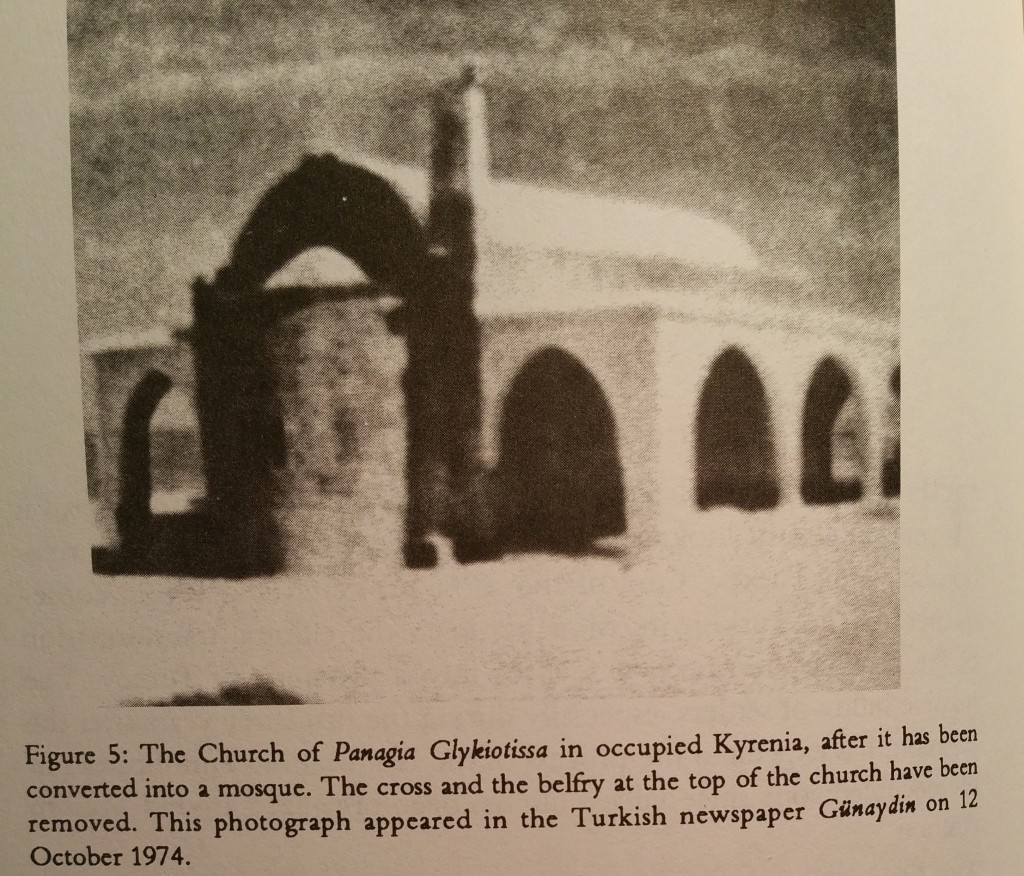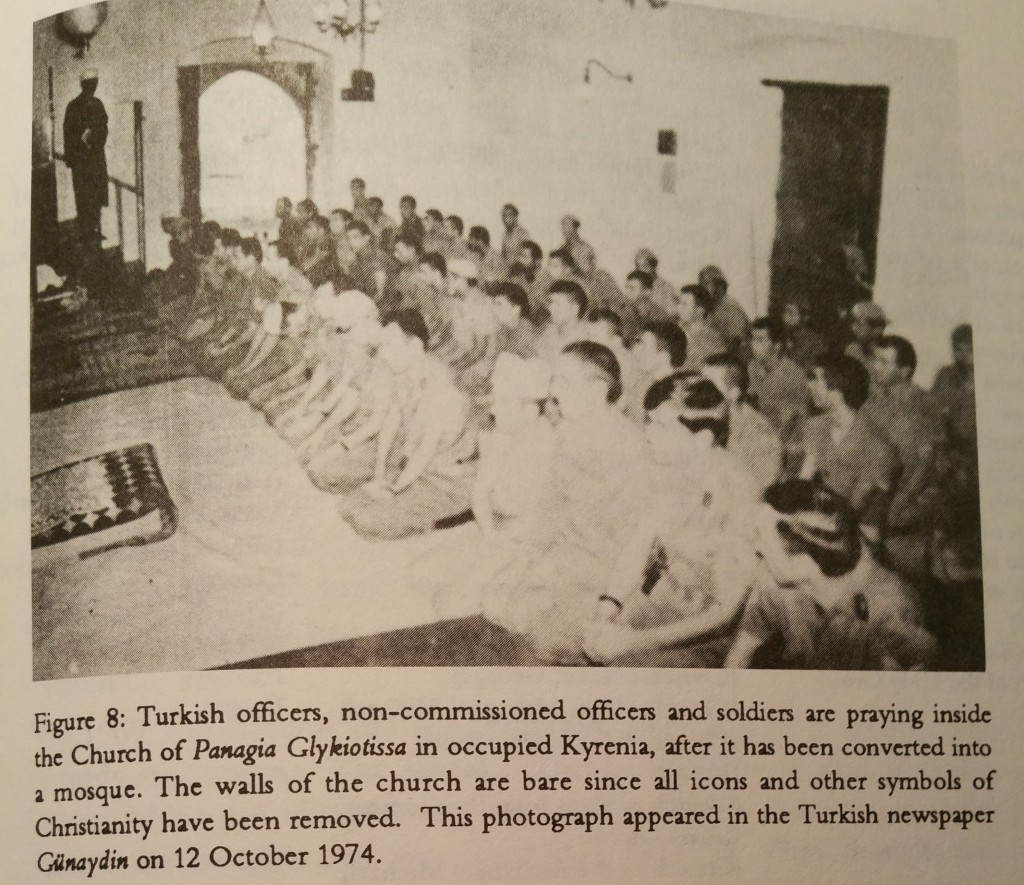July 20, 1974 Flashback: “Secular” Turkey’s Brutal Jihad Conquest and Islamization of Northern Cyprus
Northern Cyprus’ 1974 Islamization began immediately upon the Turkish army’s occupation, as described from primary (and triumphal) Turkish media sources compiled by Professor Christos P. Ioannides (“In Turkey’s Image” [1991], pp. 177ff):
One of the army’s first gestures was to convert the Church of Panagia Glykiotissa (Church of the Virgin Mary, Healer of Pain) in Kyrenia into a mosque so that the troops who had landed at a nearby beach during the invasion could pray (see washed out images, below, from a celebratory account in the Turkish newspaper, Günaydin, published October 12, 1974). There were two mosques in Kyrenia where these troops could have prayed. But this church was apparently converted into a mosque at that time for the following reasons: First, from the Turkish [my note: i.e., Islamic] point of view, the conversions symbolized the victory of the Turkish armed forces over the “unbelievers”—the Christian Greeks. Second, it signified the beginning of the Islamization process which subsequently took place throughout the newly occupied territory as church after church was converted into a mosque.
Ioannides further cites the clear Islamic religious rationale provided for these actions by a “prominent Islamic (religious) figure in Istanbul, Mufti A. Seref,” whose statement “was published in the Turkish press next to a picture of officers and soldiers praying in the Church of Panagia Glykiotissa after it had been converted into a mosque” (in the same October 12, 1974 Günaydin article). The good Mufti Seref proudly declared:
According to our religion (Islam), if needed, prayers can be held in a church but only under this condition: It is imperative that in the church there should be no religious objects of the infidels (Christians) or these objects should be covered. There should be nothing overhead that has any relationship with these objects. Then prayer can take place.


The broader context and extent of this Islamization process can be gleaned from the illustrated scholarly 2008 analysis of Chotsakoglu “Religious monuments in Turkish-occupied Cyprus : evidence and acts of continuous destruction,” (whose text can be viewed via google cache, here):
…the Christian churches remained in northern Cyprus as the only indisputable witness after 1974, proving the Greek identity, history and presence of the island. Where these churches were not destroyed, demolished or sold, they were transformed primarily into mosques or were transformed by the Turkish armed forces into military camps and storage places. The Christian churches were mostly converted into Ottoman mosques. This practice is common and began in the times of the Ottoman Empire and the later Turkish state which was subsequently exercised in Cyprus. It remains a historical fact that between the Ottoman domination (1571) of Cyprus and the British Rule (1878) the newly erected mosques by the Ottomans could hardly reach a number more than ten. All mosques of Cyprus’ main cities (e.g. Keryneia, Lefkosia, Famagusta, Pafos, Larnaka, Lemesos) were initially built as Christian churches during the Byzantine period and afterwards were transformed by the Ottomans into mosques….In cases where paintings decorated the church-walls, these were covered by non-pictorial presentations or inscriptions from the Koran, as several cases, which came to light after restoration of the Department of Antiquities, indicate (e.g. mosques of Kato Polemidia, Episkopi, Timi, Pelathousa, Polis Chrysochous).
The same practice was also followed after the 1974 invasion of the northern part of the island. Almost all central churches in towns and villages of occupied Cyprus were transformed into mosques. In several cases the iconostasis of the churches were covered with sheets, while the holy icons, relics and every movable church-object disappeared. At the southern part of the churches was built a mihrab (semicircular niche in the wall of a mosque that indicates the qibla, o Direction of prayer towards Mecca), while externally was built a minaret or if this was not the case, loudspeakers were placed at the existed belfries and water springs were built in the middle of the church-yard for the needs of the mosques. About 77 cases of registered churches where transformed into mosques. The example of the gothic cathedral of Famagusta is typical of the Ottoman behavior converting Christian churches into mosques. Right page: Detail from the central entrance of the church of St. John the Theologian in the village Mia Milia, which is today used as the main mosque for the area. The church of St. Demetrius in Leonarisso was used as a mosque before it was abandoned…(examples) from the interior of St. Andrew in the occupied part of Lefkosia, which was converted into a mosque…Turkish flags covered the iconostasis at the Holy Virgin church in Egkomi. The gold-plated ambo, the bishop’s throne and parts of the epistyle of the St. Paraskeve Church in Morfou, were adjusted for its conversion into a Muslim mosque
This past Sunday (posted at WorldNet Daily, Sunday July 17, 2016), I deconstructed the sheer uninformed nonsense endlessly spewed forth about the so-called “secular, democratic Turkish military” in the wake of Turkey’s failed military coup at the end of last week. The events of July-August 1974, and its ugly aftermath, should have resulted in jihadist Turkey’s expulsion from NATO. Instead this predatory state—a proven tool of forceful Islamization, and ethnic cleansing via jihad—still remains within NATO as a fictional “bulwark” against “anti-democratic forces.”
CLICK TO READ MORE






































No comments:
Post a Comment